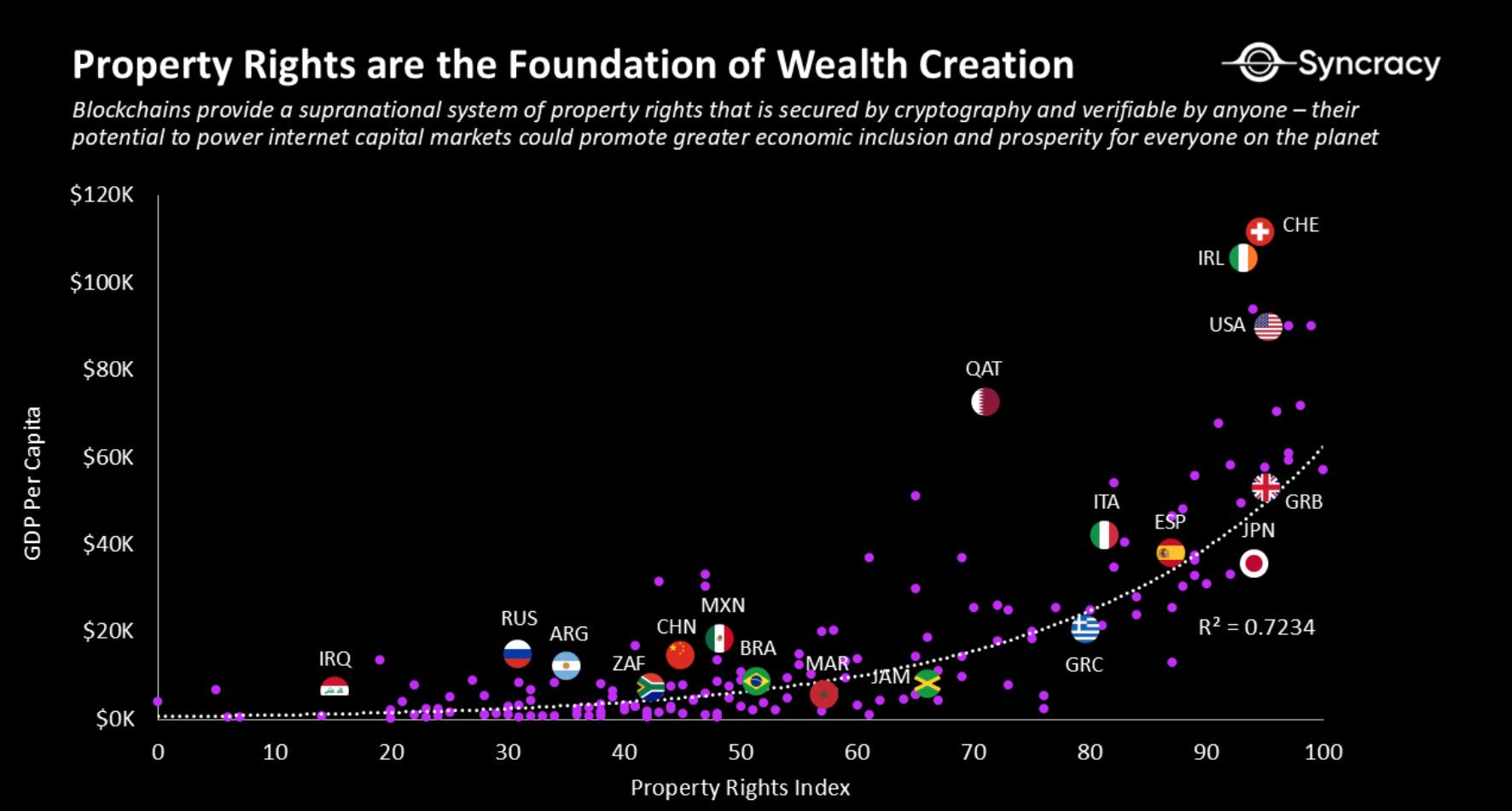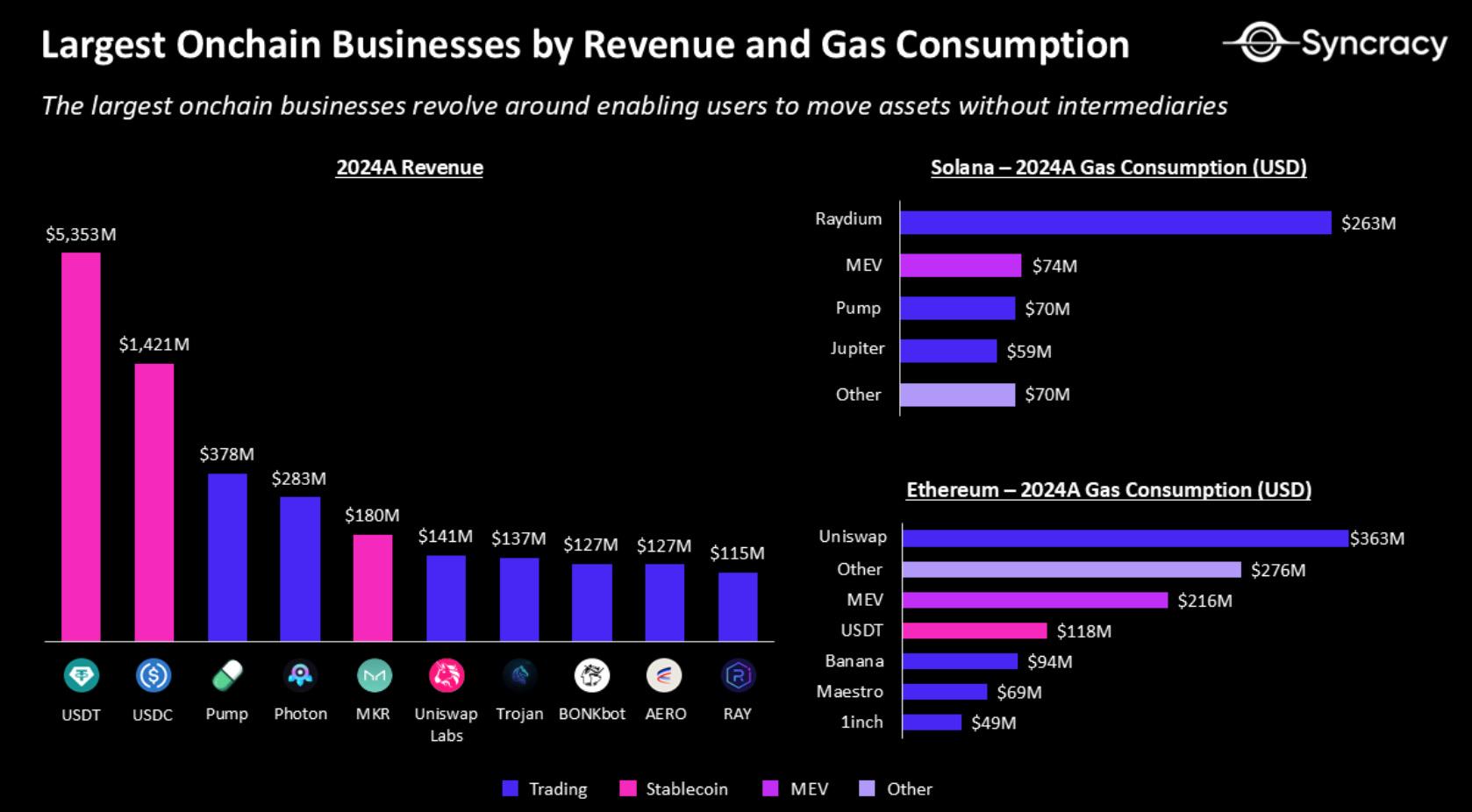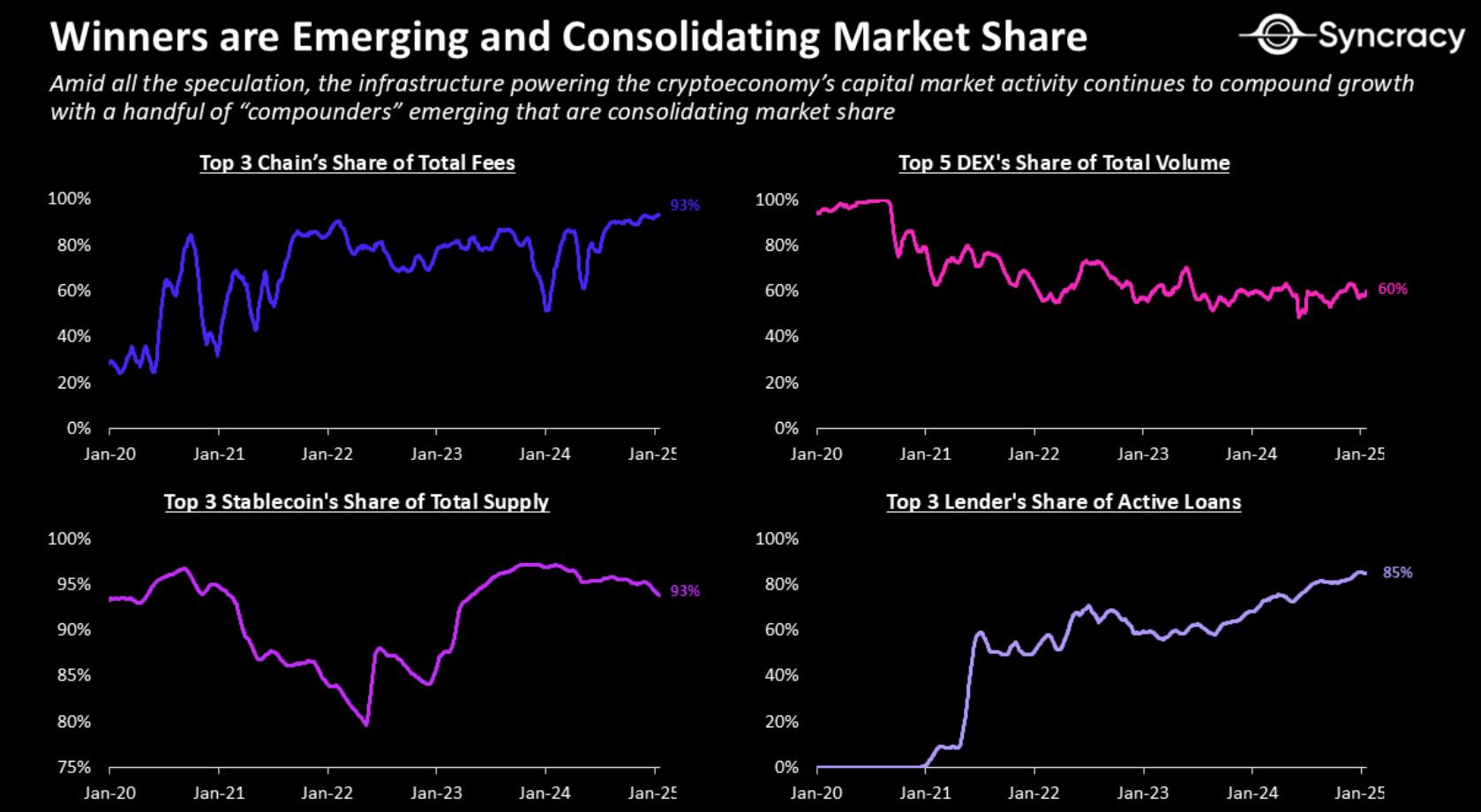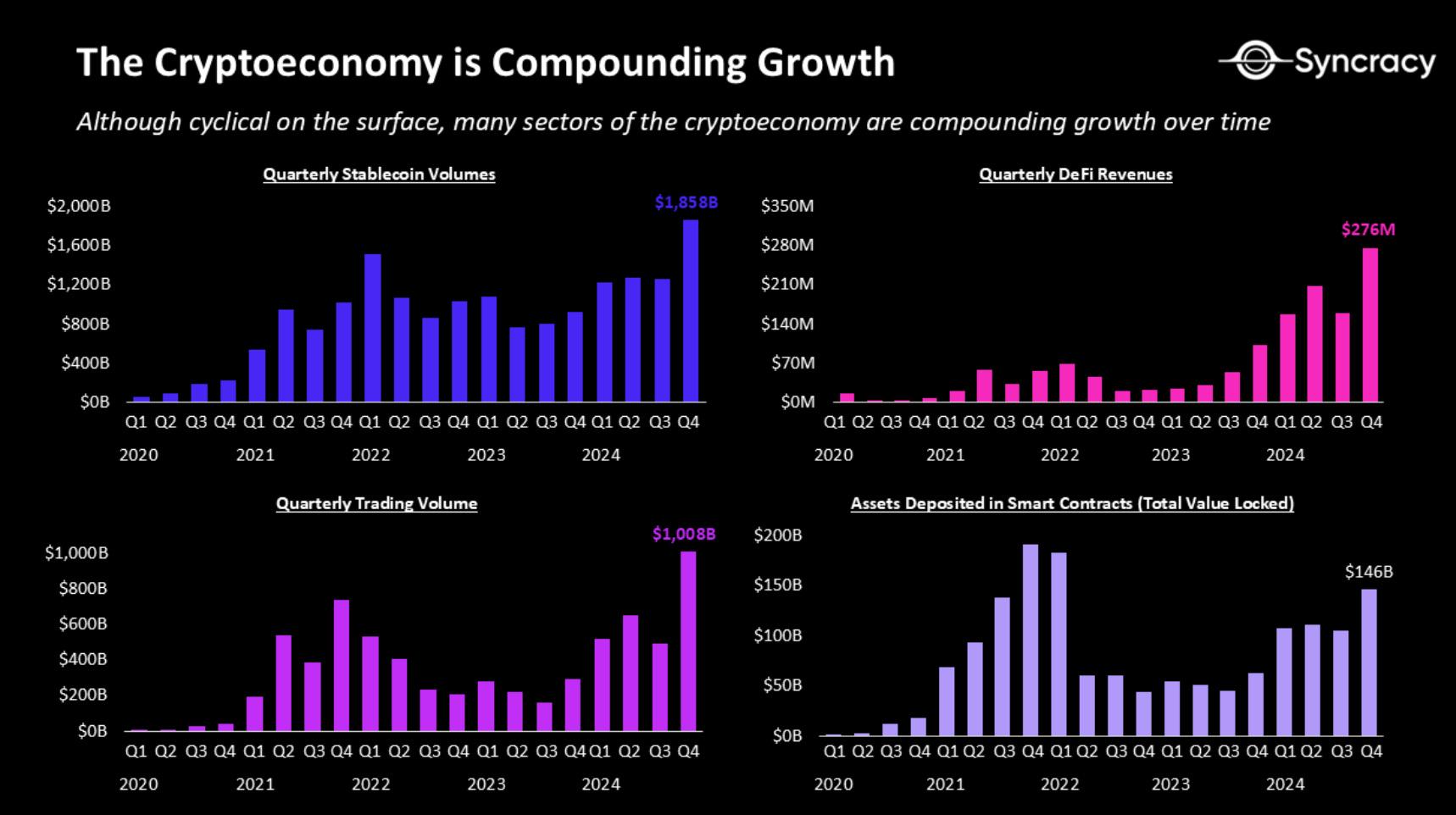Making good use of the dual nature of the crypto economy, while using speculative energy to promote financial change, it increasingly serves non-speculative use cases.
Author: Selected compilers of Techhub
Written by Ryan Watkins, co-founder of Syncracy Capital and former analyst at Messari
Compiled by: Yangz, Techhub News
Critics often cite the widespread financial nihilism in the crypto economy and believe that the economic system will eventually collapse under the weight of its excessive development. However, under the speculation that fuels this suspicion, we are also seeing some emerging “winners” that are growing over time. In this article, we will explore the contradiction between the “uselessness” and “practicality” of the crypto economy and clarify that they are actually two sides of the same coin.
“Those were the best times, those were the worst times; those were the years of wisdom, those were the years of obscurity; those were the times of confidence, those were the times of doubts; those were the season of sunshine, those were the season of darkness; those were the spring of hope, those were the winter of despair; there was everything before us, there was nothing before us; we were all flying straight to heaven, and we were all going straight to hell.”– A Tale of Two Cities by Charles Dickens
Critics often cite the widespread financial nihilism in the cryptoeconomy as evidence of its futility. Although it has been 16 years since Bitcoin was launched and 9 years since Ethereum was launched, there are still few mainstream use cases that demonstrate its undeniable usefulness.
Whenever we hear stories about emerging market users using stablecoins to protect their savings from inflation in their own countries, it seems that there will always be more developed market users investing their savings into big bets on various Memecoins.
stablecoins are liberating and destroying; blockchain is a great equalizer and a giant destroyer; the cryptoeconomy is the future of the global financial system and the greatest collective illusion in human history.
These opposing views reveal the high risk that the technology has both the potential to change the world and the potential to self-collapse due to its excessive radicalization. For many people, this contradiction raises skepticism and makes people wonder,”What does all this mean?” It also raises questions about whether it makes sense to have a long-term fundamental view of other assets in the cryptoeconomy other than Bitcoin.
However, this contradiction between “uselessness” and “practicality” is not a flaw, but a feature that is unfolding the growing pains that blockchain’s revolutionary potential is experiencing.
In a world of growing inequality between countries, blockchain technology has the potential to democratize wealth for billions of people. To understand this, we first need to understand the concept that “blockchain is a new type of institution” that allows users to conduct transactions and execute contractual relationships without intermediaries. Blockchain achieves this through a supranational property rights system secured by encryption and allowing anyone to verify it. It is a subtle but powerful tool that can be used to create a level economic playing field.
Blockchain relies on the cloud to operate, and the only physical existence is thousands of computers distributed around the world, and the integrity of the network is jointly maintained by these computers. Together, these computers create the Internet-native infrastructure for the market, which is by far the closest mechanism to achieving the “perfect information” needed for effective resource allocation.

Equity index; data source: The Global Economy, International Monetary Fund
Ronald Coase’s groundbreaking paper “The Nature of the Firm” published in 1937 best illustrates the significance of this change. Coase believes that companies exist because the costs of finding information in the market, negotiating agreements and enforcing contracts outweigh the efficiency of outsourcing.
Blockchain has fundamentally changed this situation. Automated execution through encryption technology, blockchain can make information universally available and reduce reliance on intermediaries, significantly reducing transaction costs, especially when combined with Internet-age assistive technologies such as search engines and “gig economy” platforms. As transaction costs fall, so does the demand for large tiered companies, paving the way for a blockchain-based global market structure. This structure can maximize economic production, improve market efficiency, and lay the foundation for a completely new market.

The largest on-chain "business" by revenue and Gas consumption in 2024; data sources: DeFiLlama, Artemis, Top Ledger
The crypto economy has demonstrated these advantages. stablecoins promote economic growth and financial inclusion by providing cheap, reliable money to users around the world; global exchanges and lending platforms create more efficient markets and democratize access to capital markets; and DePIN creates a new market that allows users to coordinate and monetize different physical and digital resources. All of these use cases are extremely efficient and have software-like profit margins, while blockchain automatically handles most of the back-end infrastructure and settlement activities. Large financial institutions and companies are slowly realizing this potential, with many either launching products directly on blockchain or integrating blockchain-based projects into back-end infrastructure for existing products.
So why are anyone still skeptical about the crypto economy?
The superposition of practicality and uselessness
Creating a decentralized infrastructure for trading and enforcing contracts inevitably triggers unlimited experimentation. Since the potential user base of blockchain covers billions of Internet users around the world, the momentum of such experiments is also extremely strong. Even world leaders are issuing their own currencies. The temptation of opportunity allows the rapid proliferation of new assets and financial agreements, ranging from transformative innovations to outright scams.
Although these attempts may seem reckless, they are not much different from the situation during the dotcom bubble. At that time, many companies often went public with only one domain name. In contrast, the crypto economy amplifies this dynamic to the extreme, providing anyone with an Internet-scale capital market. This provides an unprecedented stage for innovation and speculation, ultimately accelerating the pace of discovery and adoption. After all, before trillions of dollars of future value enter the blockchain space, speculation will attract new users and provide much-needed stress testing for the system.

"Winners" are emerging and consolidating market share; data sources: DeFiLlama, Artemis, Token Terminal
However, among all speculative activities, a few “winners” have begun to emerge. Many projects are driving speculation in capital markets that dominate the headlines and achieve compound growth behind the scenes. These “winners” are rare “compounders” who are consolidating market share, expanding their capabilities, and increasingly serving non-speculative use cases over time. These projects will ultimately provide the backbone for the crypto economy to mature and scale globally.
Will parallel paths intersect?
For the foreseeable future, Syncracy believes that the best way to explain the basic arguments of the cryptoeconomy is to find assets that are both robust and capable of capturing the speculative momentum inherent in Internet capital markets. This is not an esoteric statement, because in practice, it just means embracing the fast-growing projects that people actually use. For now, this also means increasing trading volume, such as directly monetizing speculative activity on the chain through asset issuers or market platforms such as exchanges, or investing in its underlying infrastructure, such as L1. These L1s not only monetize speculative activity, they also provide a flexible valuation framework because they are often priced as assets similar to currencies.
In fact, long speculation through infrastructure (the fast-growing items that people actually use) has been a common denominator for many of the biggest winners in this cycle. Solana provides first-class performance, making the online trading experience similar to traditional retail trading platforms (such as Robinhood);Phantom creates a user-friendly experience similar to Apple and pays special attention to mobile applications, allowing users to speculate anytime and anywhere in an unprecedented way;Pump.fun compresses the cost, energy and resources required to launch new tokens;Hyperliquid gives on-chain traders the feeling of using a centralized exchange, but with lower costs and fewer thresholds and restrictions; Virtuals and ai16z (Eliza) allow anyone to launch artificial intelligence agents with associated tokens and wallets;Telegram robots and token discovery tools such as Photon and DexScreener have brought light to the chain economy and made it easy to access from familiar applications. There are countless such examples.

The crypto economy is growing compound; data sources: DeFiLlama, Artemis
Eventually, we will move beyond this model of relying on speculative projects to attract extraordinary attention and traffic, especially as more institutional investors enter this asset class. At the same time, there are many projects in DeFi and DePIN that are not speculative but promising, and they are on the “slope of enlightenment”(iePhase 4 in Gartner’s technology maturity curve: Technological advantages begin to emerge and gain broader understanding) Increase steadily. These projects have shown early signs of product fit to the market and improvement in fundamentals. While these assets may take time to achieve valuation growth, they also urgently need a clear regulatory framework to move them into the mainstream. Although some tracks (such as stablecoins) have pointed the way forward for the industry and confidently entered the deployment phase of the life cycle, given the current complex crypto-economic activity, bystanders can still find many counterexample to interpret them according to their own prejudices.
Still, from an investment perspective, our current goal is to cultivate long-term participants and make good use of the dual nature of the crypto economy, leveraging speculative energy to drive financial change while increasingly serving practical, non-speculative use cases. Such assets can achieve compound benefits over time, rather than being caught in a “game of rotation” like other more narratives driven assets in the crypto economy. These assets will ultimately lead the world’s transition to the chain, as the speculation they drive will attract new users and provide much-needed stress testing before trillions of dollars of activity enter the blockchain space in the next few years.
In fact, uselessness and practicality are like two sides of a coin.



